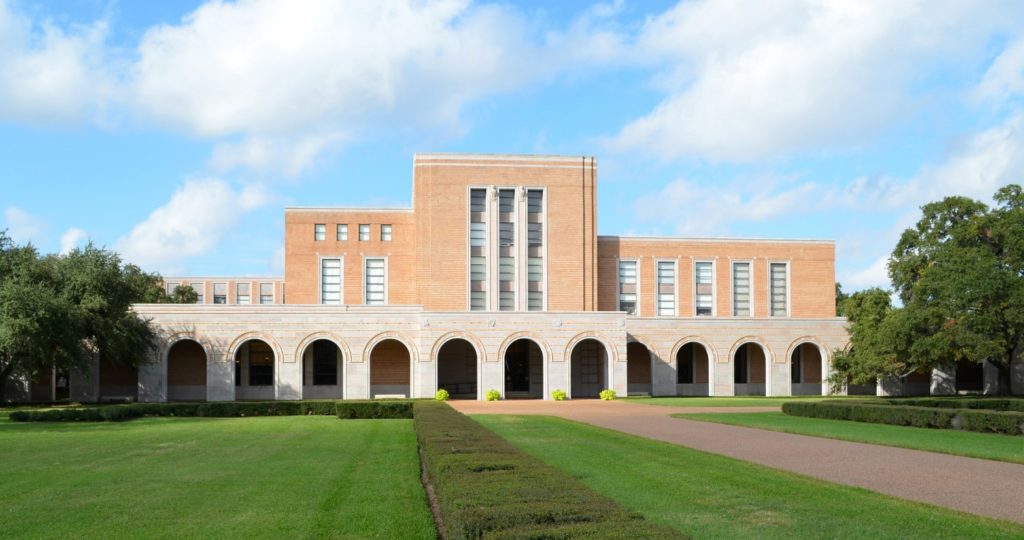Rice University

William Marsh Rice University, typically known as Rice University, is a private research study university in Houston, Texas. The university is situated on a 300-acre (121 ha) school near the Houston Museum District and is surrounding to the Texas Medical.
Opened in 1912 after the murder of its namesake William Marsh Rice, Rice is now a research university with an undergraduate focus. Rice is kept in mind for its applied science programs in the fields of artificial heart research, structural chemical analysis, signal processing, space science, and nanotechnology. Rice is a member of the Association of American Universities.
The university is arranged into eleven residential colleges and 8 schools of scholastic study, consisting of the Wiess School of Natural Sciences, the George R. Brown School of Engineering, the School of Social Sciences, School of Architecture, Shepherd School of Music and the School of Humanities. Rice’s undergraduate program uses more than fifty majors and two dozen minors, and allows a high level of flexibility in pursuing several degree programs. Additional graduate programs are offered through the Jesse H. Jones Graduate School of Business and the Susanne M. Glasscock School of Continuing Studies. Rice trainees are bound by the strict Honor Code, which is imposed by a student-run Honor Council
Rice competes in 14 NCAA Division I varsity sports and is a part of Conference USA, typically competing with its cross-town competitor the University of Houston. Intramural and club sports are offered in a wide variety of activities such as jiu jitsu, water polo, and team.
The university has produced many popular alumni, consisting of more than 2 lots Marshall Scholars and a dozen Rhodes Scholars. Offered the university’s close links to NASA, it has actually produced a substantial number of astronauts and area scientists. In business, Rice graduates have actually ended up being CEOs and founders of Fortune 500 companies; in politics, alumni have won positions as congressmen, cabinet secretaries, judges, and mayors. Houston Texas Information.
|
Former names
|
William M. Rice Institute for the Advancement of Literature, Science and Art (1912–1960) |
|---|---|
| Motto | Letters, Science, Art |
| Type | Private, non-profit |
| Established | 1912 |
|
Academic affiliations
|
AAU ORAU NAICU URA CONAHEC SURA |
| Endowment | $6.48 billion (2019) |
| President | David Leebron |
| Provost | Marie Lynn Miranda |
|
Academic staff
|
680 full time |
|
Administrative staff
|
2,152 |
| Students | 7,124 (Fall 2018) |
| Undergraduates | 3,992 (Fall 2018) |
| Postgraduates | 3,132 (Fall 2018) |
| Location |
Houston
, Texas
, United States
29°43′1″N 95°24′10″WCoordinates: 29°43′1″N 95°24′10″W |
| Campus | Urban, 300 acres (120 ha) |
| Colors | Blue and gray |
| Nickname | Owls |
|
Sporting affiliations
|
NCAA Division I – C-USA |
| Mascot | Sammy the Owl |
| Website | www |
History
Rice University’s history began with the untimely death of Massachusetts businessman William Marsh Rice, who made his fortune in genuine estate, railroad advancement and cotton trading in the state of Texas. The attorney, Albert T. Patrick, then announced that Rice had changed his will to leave the bulk of his fortune to Patrick, rather than to the creation of Rice’s academic institute. Baker helped Rice’s estate direct the fortune, worth $4.6 million in 1904 ($ 131 million today), towards the founding of what was to be called the Rice Institute, later to become Rice University.
In 1907, the Board of Trustees chose the head of the Department of Mathematics and Astronomy at Princeton University, Edgar Odell Lovett, to head the Institute, which was still in the planning phases. Lovett carried out extensive research study prior to formalizing strategies for the brand-new Institute, consisting of check outs to 78 organizations of greater learning throughout the world on a long trip in between 1908 and 1909. Lovett was impressed by such things as the aesthetic appeal of the uniformity of the architecture at the University of Pennsylvania, a style which was adopted by the Institute, as well as the residential college system at Cambridge University in England, which was added to the Institute a number of years later.
Campus
Rice’s campus is a greatly woody 285-acre (115-hectare) system of land in the museum district of Houston, located near to the city of West University Place.
Five streets demarcate the campus: Greenbriar Street, Rice Boulevard, Sunset Boulevard, Main Street, and University Boulevard. For the majority of its history, all of Rice’s structures have been consisted of within this “external loop”. Over the last few years, brand-new centers have actually been built near campus, however the bulk of administrative, scholastic, and residential structures are still located within the initial pentagonal plot of land. The brand-new Collaborative Research Center, all graduate student housing, the Greenbriar structure, and the Wiess President’s House lie off-campus.
Rice prides itself on the amount of green area readily available on school; there are only about 50 structures spread between the primary entryway at its easternmost corner, and the parking area and Rice Stadium at the West end. The Lynn R. Lowrey Arboretum, including more than 4000 trees and shrubs (giving birth to the legend that Rice has a tree for every student), is spread throughout the campus.
The university’s very first president, Edgar Odell Lovett, meant for the campus to have a consistent architecture design to improve its aesthetic appeal. To that end, nearly every structure on school is significantly Byzantine in style, with sand and pink-colored bricks, large archways and columns being a common style amongst lots of campus structures. Noteworthy exceptions consist of the glass-walled Brochstein Pavilion, Lovett College with its Brutalist-style concrete gratings, Moody Center for the Arts with its modern style, and the eclectic-Mediterranean Duncan Hall. In September 2011, Travel+Leisure listed Rice’s school as one of the most stunning in the United States.

